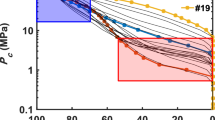Abstract
By analyzing hundreds of capillary pressure curves, the controlling factors of shape and type of capillary pressure curves are found and a novel method is presented to construct capillary pressure curves by using reservoir permeability and a synthesized index. The accuracy of this new method is verifi ed by mercury-injection experiments. Considering the limited quantity of capillary pressure data, a new method is developed to extract the Swanson parameter from the NMR T 2 distribution and estimate reservoir permeability. Integrating with NMR total porosity, reservoir capillary pressure curves can be constructed to evaluate reservoir pore structure in the intervals with NMR log data. An in-situ example of evaluating reservoir pore structure using the capillary pressure curves by this new method is presented. The result shows that it accurately detects the change in reservoir pore structure as a function of depth.
Similar content being viewed by others
References
Coates, G. R., Xiao, L. Z., and Primmer, M. G., 2000, NMR logging principles and applications: Gulf Publishing Company, Houston, USA, p42–78.
Guo, B. Y., Ghalambor, A., and Duan, S. K., 2004, Correlation between sandstone permeability and capillary pressure curves: Journal of Petroleum Science and Engineering, 43(3), 239–246.
Liao, M. G., and Fu, X. W., 2000, Inverse model of capillary pressure curve for sandstone reservoir rocks: Journal of Southwest Petroleum Institute (in Chinese), 22(4), 5–8.
Mao, Z. Q., Kuang, L. C., Sun, Z. C., Luo, X. P., and Xiao, L., 2007, Effects of hydrocarbon on deriving pore structure in formation from NMR T 2 data: SPWLA 48th Annual Logging Symposium, paper W.
Swanson, B. F., 1981, A simple correlation between permeabilities and mercury capillary pressure: Journal of Petroleum Technology, 47(6), 2498–2503.
Xiao, L., 2007, Studies of method for constructing NMR capillary pressure curve and its application: Dissertation, China University of Petroleum (Beijing), 47–69.
Xiao, L., Liu, X. P., Chen, Z. M., Xu, R. and Mao, Z. Q., 2007, Review of methods for constructing capillary pressure curve by NMR logging: Fault-Block Oil & Gas Field (in Chinese), 14(2), 84–86.
Xiao, L., 2008, Application of NMR log data to evaluation of formation pore structure: Xinjiang Petroleum Geology (in Chinese), 29(2), 260–264.
Xiao, Z. X., Xiao, L., and Zhang, W., 2008, A new method for calculating sandstone permeability by using capillary pressure curves: Geophysical Prospecting for Petroleum (in Chinese), 47(2), 204–207.
Yakov, V., 2001, A practical approach to obtain primary drainage capillary pressure curves from NMR core and log data: Petrophysics, 42(4), 334–343.
Zhong, D. K., 1997, The fitting of capillary pressure curves of reservoirs and its geological applications: Acta Sedimentologica Sinica (in Chinese), 15(3), 162–164.
Author information
Authors and Affiliations
Rights and permissions
About this article
Cite this article
Liang, X., Wei, Z. A new method to construct reservoir capillary pressure curves using NMR log data and its application. Appl. Geophys. 5, 92–98 (2008). https://doi.org/10.1007/s11770-008-0017-3
Received:
Revised:
Published:
Issue Date:
DOI: https://doi.org/10.1007/s11770-008-0017-3




